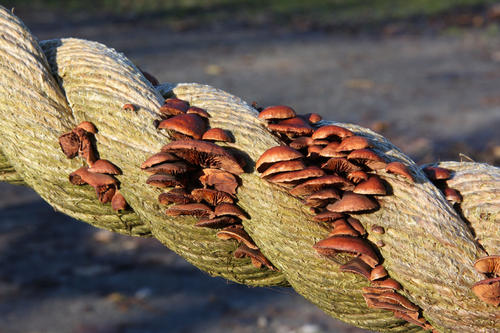Fender Fungus Melanotus horizontalis
Arthur W. Cundall
On 17th November 2012 I was visiting the National Trust property Croome Court, at SO 887451, with my family. Immediately in front of the House an area of waste material had been cordoned off by means of a rope, supported at intervals by metal posts. My son-in law, Denis Kilner, noticed that on several of the 2 inch diameter rope catenaries there were clusters of a chestnut coloured bracket-type fungus. It was considered imprudent to collect samples, but a hasty photograph was taken. This was shown to John Meiklejohn, who was unable to suggest an identification.
Following a period of floods, during which the property was closed, a return visit was made on 29th November 2012, when the fungal growth was found to have deteriorated, though still present. Another roped off area, 1km distant at SO 886446 was found to have younger, identical growths, which were photographed under better conditions (Fig. 1.). A few samples of the stem-less fruiting bodies were collected from which a spore cast was taken and submitted to John Meiklejohn who was unable to obtain an identification. He then sent the specimens to the Mycology Department at Kew for their opinion.
The reply from Dr A Martyn Ainsworth, Senior Researcher in Fungal Conservation, stated that he had identified the fungus as Melanotus horizontalis, the usual habitat for which was wood of various sorts and dead stems such as bracken. However, there were previous British records of it living on rope, leading to the common name “Fender Fungus.” He stated that he had added the specimens to the collection at Kew as K(M)18705.
The occurrence of this uncommon fungus growing on an uncommon host is the first record for Worcestershire. The invaluable assistance provided by John Meiklejohn in obtaining an identification is acknowledged.
Reference.
Shattock, J & R. 2006. Fender Fungus. Field Mycology7 (3):79-80.
Image
Fig.1. Melanotus horizontalis. Arthur Cundall
